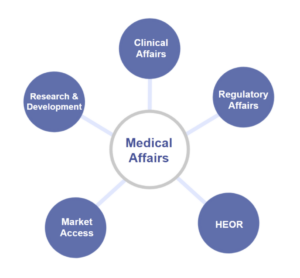Medical Affairs
Software for Evidence Synthesis
Connect Evidence All in One Place
While current processes are static and fragmented, Medical Affairs teams are well-positioned to serve as the single source of truth for the entire organization, and beyond.
The evolution of the medical affairs (MA) profession is a dynamic process. In today’s landscape, the abundance of data from diverse sources such as medical records, peer-reviewed studies, and even social media posts are playing a pivotal role in shaping this evolution. This wealth of data has the potential to wield a profoundly positive impact, underscoring the heightened significance of examining the role and significance of scientific communication platforms (SCPs) for MA professionals and their integral role in ensuring the successful introduction of therapies.
Capturing the perspectives of both conventional, academically-oriented thought leaders (TLs) and the practical insights held by treating physicians is imperative for MA teams. The reality underscores the existence of a perceptible gap between these two distinct audiences in terms of their perceptions and viewpoints regarding diseases.
Many organizations fall into the presumption that medical practitioners in the field will inherently grasp the scientific nuances and recognize the value of their product. It is essential to move beyond these assumptions to ensure alignment between the messaging and the evidence for the utilization of the treatment or product
Ultimately, Medical Affairs professionals must ensure that physicians as well as all other stakeholders possess comprehensive knowledge about the safety and efficacy of a given product. To that end, a scientific platform must serve as a basis for consistent and rapid synthesis of diverse and myriad streams of evidence.
The role of medical affairs is in a state of ongoing transformation, evolving from a predominantly operational function into a strategically pivotal one. This shift is of paramount significance, particularly as medical affairs assume the crucial role of connecting national and local thought leaders. Leveraging the capabilities of the Scientific Communication Platform (SCP), professionals in medical affairs can harness the power of extensive data and sophisticated analytics to bridge informational divides. Ultimately, this endeavor serves the dual purpose of advancing the objectives of the companies they are affiliated with while also fostering the well-being of healthcare providers and their patients.
Nested Knowledge can enable medical affairs teams to present data in the most effective manner. Nested Knowledge gives Medical Affairs Professionals the ability to create a better, truly living scientific platform. NK can provide clients and your entire team with the evidence and data needed to simplify complex medical diction for all parties to better comprehend.
With the power you have to conduct reviews with Nested Knowledge, all your diverse data can be presentable in one place. From a meta-analysis of clinical trials and research to studies in varied sectors, NK creates a living Nest for your reviews now and in the future.
Publication Planning
Creating a strategic publication plan is essential to ensure that stakeholders can readily access the information required to grasp the potential advantages of a pharmaceutical product.
Connected Evidence
Easily track and connect all of your data in one place to better define relationships between concepts.
Clinical Comparisons
Compare the intervention under review with comparators to ascertain the safety and efficacy relative to similar interventions.
Vivid Visualization
The plethora of models and visuals make presenting findings and evidence engaging and meaningful.
Living Evidence
Evidence That Matters
Adopting a forward-thinking and strategic approach to planning guarantees the timely availability of impactful evidence.
IEP examines the comprehensive strategies and methodologies for generating, analyzing, and disseminating evidence throughout the lifecycle of pharmaceutical products.
The IEP systematically monitors gaps in evidence and corresponding plans for generating evidence, encompassing data origins, endpoints, and scheduling, alongside strategies for sharing findings. The IEP cultivates a cohesive approach that harmonizes diverse cross-functional departments within the organization. The IEP serves as an internal document strategically arranging evidence-generation needs across functions, countries, and the product life cycle. It also functions as a dynamic “living record,” subject to regular updates in response to external market dynamics and internal demands.
IEP is beneficial to an organization by being able to monitor all present and future evidence-generation endeavors and facilitating the identification of shared elements across multiple functions. By adhering to a structured methodology in its development, the IEP establishes a uniform framework spanning all operational functions. Facilitates the prioritization of evidence-generation requirements and aids in resource allocation decisions, thereby enabling the removal of redundant and low-impact research. This process ensures comprehensive gap identification and prioritization.
Nested Knowledge offers organizations a comprehensive solution encompassing these advantageous functionalities. With a singular, encompassing tool, Nested Knowledge facilitates evidence assessment, gap analysis, and competitor evaluation. Furthermore, Nested Knowledge empowers users in evidence generation, providing a holistic approach to enhancing decision-making processes. By using Nested Knowledge to gather specific types of evidence in specific ways, you can ensure teams across your organization are adhering to your IEP.
Think of NK as the set of tools, and the IEP as the blueprint. Ultimately, the IEP plays a pivotal role in bolstering product positioning, thus maximizing the realization of the brand’s overarching vision.


Living HTA
How do you keep up? The future is living evidence.
HTAs are typically performed as one-off evaluations but rapidly become out-of-date due to the availability of new data, new comparators, or other factors.
Recently, living approaches have been applied to systematic reviews and network meta-analyses to enable evidence syntheses to be updated more easily…such a living approach could be applied to the entire HTA process.
Thokala P, Srivastava T, Smith R, Ren S, Whittington MD, Elvidge J, Wong R, Uttley L. Living Health Technology Assessment: Issues, Challenges and Opportunities. Pharmacoeconomics. 2023 Mar;41(3):227-237. doi: 10.1007/s40273-022-01229-4. Epub 2023 Jan 18. PMID: 36652184; PMCID: PMC9848020.
Tools for Ongoing Analysis
Living Evidence Libraries
By centralizing all of the relevant data in a single, easily accessible platform, Nested Knowledge allows HEOR teams to continuously synthesize in the background, while offering instant, curated access on to key stakeholders.
Keep everyone on the same page throughout the entire product lifecycle, for every product in your portfolio.
See it in Action
Experience Living Evidence
This interactive Qualitative Synthesis visualization results from the careful combination of all currently available and published evidence for treatment of Basilar Artery Stroke with Endovascular Thrombectomy. Updated continuously in the background, this point-and-click interface allows you to review hand-picked insights, then explore the sunburst diagram or select a specific study to trace insights back to the source.
By creating the best systematic review, meta-analysis, and evidence synthesis tools available, Nested Knowledge allows you and your clients to focus on analyzing the outcomes associated with interventions and comparators across populations.
Start tracking hundreds of variables concurrently with Nested Knowledge.
Global impact
Deploy Nested Knowledge
Living evidence enables you serve all markets, both familiar and new, simultaneously.
- SLR of clinical data for the technology and its comparators
- Critical appraisal of RCTs and non-RCTs
- SLR of economic models for technology
- Critical appraisal of economic models
- SLR of utility data
- SLR of resource use and cost data
- Epidemiological Data
